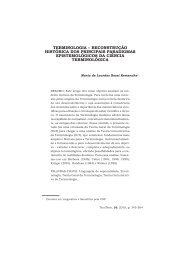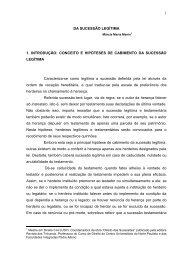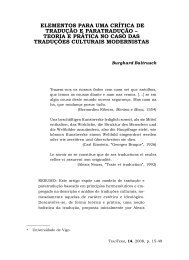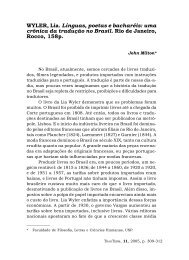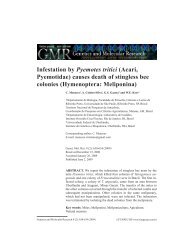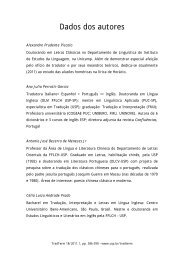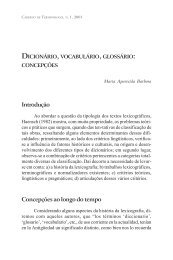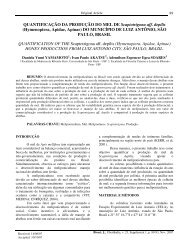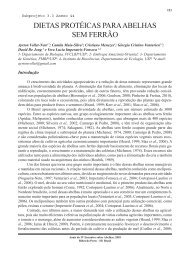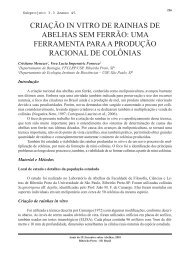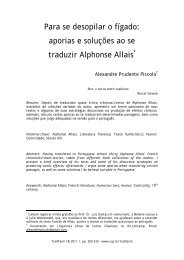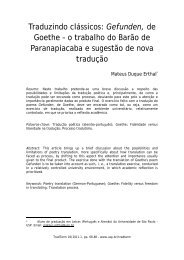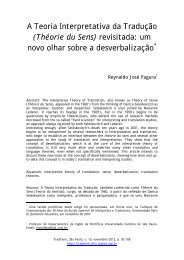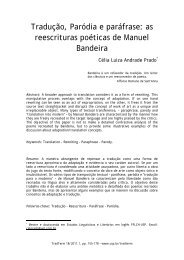Bees as pollinators in Brazil - USP
Bees as pollinators in Brazil - USP
Bees as pollinators in Brazil - USP
You also want an ePaper? Increase the reach of your titles
YUMPU automatically turns print PDFs into web optimized ePapers that Google loves.
Proposed methods:<br />
• Molecular techniques (microsatellites, allozymes) to evaluate genetic diversity and dynamics;<br />
<strong>in</strong>breed<strong>in</strong>g depression, levels of outcross<strong>in</strong>g, pollen flow, cross-compatibility between varieties<br />
of cultivars and clones.<br />
• Poll<strong>in</strong>ator behaviour <strong>in</strong> flowers and among plants.<br />
• Statistical comparison of productivity parameters between cultivars.<br />
3.Traditional methods of exploitation of timber and NTFP (non-timber forest products) should be<br />
re-evaluated.<br />
Natural stand exploitation practices may be reduc<strong>in</strong>g genetic variability and gene flow.<br />
Proposed methods:<br />
• Molecular techniques (microsatellites) to evaluate genetic diversity, mat<strong>in</strong>g systems, and gene flow.<br />
• Observation of flight patterns of each poll<strong>in</strong>ator species.<br />
4. GMO crops with geographically close wild relatives should receive priority <strong>in</strong> environmental impact<br />
<strong>as</strong>sessment actions.<br />
Crops such <strong>as</strong> cotton and corn may hybridize with wild relatives and these may become "superweeds".<br />
Proposed methods:<br />
• Paternity analysis (microsatellites).<br />
• Investigate time (phenology) or biological barriers (common <strong>poll<strong>in</strong>ators</strong>).<br />
• Observation of flight patterns of each poll<strong>in</strong>ator species.<br />
5. Conta<strong>in</strong>ment me<strong>as</strong>ures should be tested and proposed <strong>in</strong> the c<strong>as</strong>e of any crop that h<strong>as</strong> a risk of<br />
gene escape or h<strong>as</strong> to ma<strong>in</strong>ta<strong>in</strong> its purity.<br />
Exist<strong>in</strong>g conta<strong>in</strong>ment me<strong>as</strong>ures are still under development and have shown to be <strong>in</strong>efficient <strong>in</strong><br />
many c<strong>as</strong>es.<br />
Proposed methods:<br />
• Test and adoption of physical barriers that discourage poll<strong>in</strong>ator flight.<br />
• Observation of flight patterns of each poll<strong>in</strong>ator species.<br />
• Paternity analysis (microsatellites).<br />
• Production of gene flow curves.<br />
Poll<strong>in</strong>ator conservation<br />
Workshop I 45<br />
1. The percentage of legally determ<strong>in</strong>ed uncultivated land <strong>in</strong> private properties (known <strong>as</strong> "reserva<br />
legal") <strong>in</strong> <strong>Brazil</strong>ian biomes such <strong>as</strong> the Amazon forest and Cerrado (savanna) should be ma<strong>in</strong>ta<strong>in</strong>ed<br />
and enforced by law.<br />
These are<strong>as</strong> are important both to susta<strong>in</strong> ecological services, such <strong>as</strong> poll<strong>in</strong>ation, and to ma<strong>in</strong>ta<strong>in</strong><br />
gene flow and diversity of native plant species.



